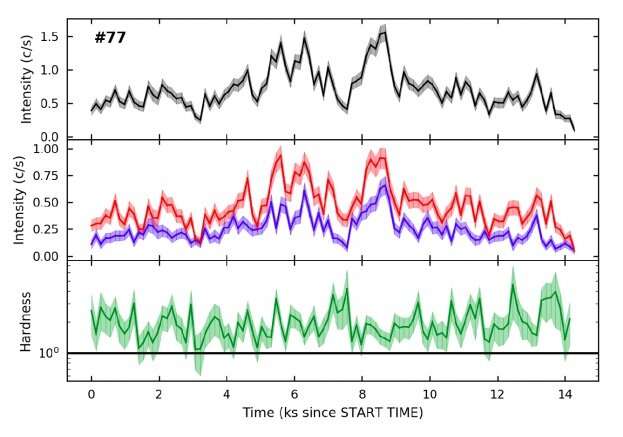January 6, 2021 report
Supergiant eclipsing binary IGR J18027–2016 investigated in detail

Using data from ESA's XMM-Newton and NASA's Swift spacecraft, astronomers have conducted a detailed temporal and spectral study of an eclipsing supergiant X-ray binary known as IGR J18027–2016. Results of this research provide important insights into the properties of this system. The study was published December 28 on arXiv.org.
X-ray binaries consist of a normal star or a white dwarf transferring mass onto a compact neutron star or a black hole. Based on the mass of the companion star, astronomers divide them into low-mass X-ray binaries (LMXBs) and high-mass X-ray binaries (HMXBs).
Taking into account the spectral type of the companion star, the accretion mechanisms taking place, and their X-ray behavior, HMXBs are further classified into Be (later called BeXBs) or supergiant X-ray binaries (SgXBs). Observations show that in SgXBs, compact objects are typically in short orbits (periods between one and 10 days) around an OB supergiant companion. In such systems, accretion can be driven by a powerful supergiant stellar wind.
Located some 40,400 light years away, IGR J18027–2016 is an obscured SgXB discovered by the International Gamma-Ray Astrophysics Laboratory (INTEGRAL) spacecraft. Follow-up observations of this system found that it is an eclipsing HMXB composed of an X-ray pulsar accreting from the wind of a late OB supergiant star with a radius of about 20 solar radii. The orbital period of IGR J18027–2016 was calculated to be approximately 4.57 days.
Previous studies suggested that stellar wind clumps may be responsible for the short- and long-term variability and spectral behavior of IGR J18027–2016. In order to further investigate this hypothesis, a team of astronomers led by Federico A. Fogantini of the Argentine Institute of Radio Astronomy has performed a detailed temporal and spectral analysis of all publicly available XMM-Newton and Swift observations of this system.
"We aim at investigating the geometrical and physical properties of stellar wind structures formed by the interaction between the compact object and the supergiant star. In this work, we analyze the temporal and spectral evolution of this source along its orbit using six archival XMM-Newton observations and the accumulated Swift/BAT [Burst Alert Telescope] hard X-ray light curve," the astronomers wrote in the paper.
The data show that IGR J18027-2016 has an asymmetric eclipse profile that spans a fraction of about 0.2 of the total orbital cycle. The light curves show that the source hardens during the ingress and egress of the eclipse.
According to the study, the light curves in the soft and hard energy bands exhibit similar flaring behavior, what points to stellar wind accretion as the origin of the X-ray emission from the source.
Furthermore, the spectra show a highly absorbed power-law-like continuum with Fe line and absorption features strongly dependent on the orbital phase. The researchers found that the absorption column density before eclipse is about 1.5 times higher than that of the eclipse egress transition.
Trying to explain the observed behavior of IGR J18027–2016, the researchers consider a photoionisation wake trailing the neutron star and an accretion wake.
"Combining the physical properties derived from the spectral analysis, we propose a scenario where a photo-ionization wake (mainly) and an accretion wake (secondarily) are responsible for the orbital evolution of the absorption column, the continuum emission and the variability seen at the Fe-line complex," the authors of the paper wrote.
More observations of IGR J18027–2016, mainly at phases before the eclipse and after inferior conjunction, could be helpful in confirming the assumptions presented in the study.
More information: Stellar wind structures in the eclipsing binary system IGR J18027–2016, arXiv:2012.14460 [astro-ph.HE] arxiv.org/abs/2012.14460
© 2021 Science X Network




















